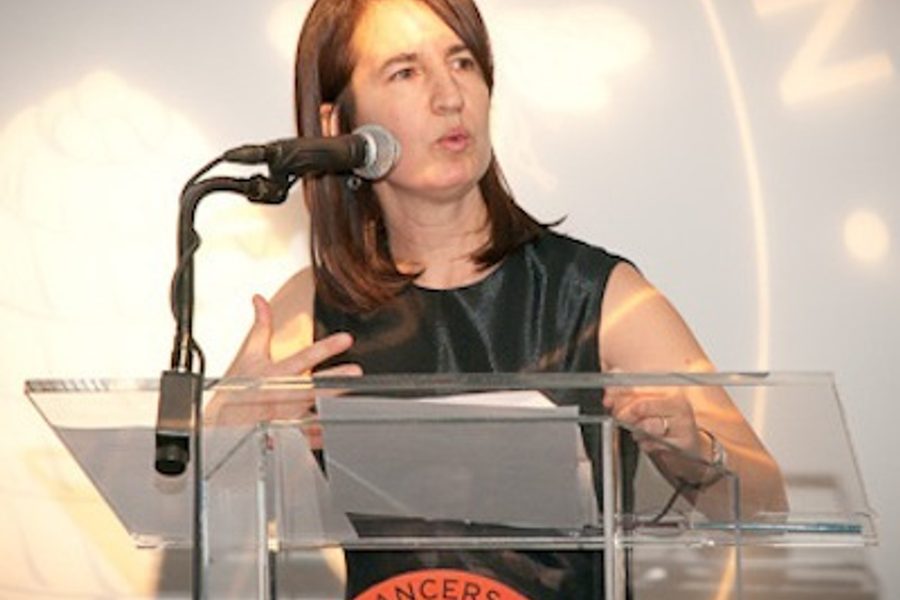
The setting for labor lawyer Sara Horowitz’s recent author talk in Chicago was itself a fantastic advertisement for the freelancing lifestyle. The November 14 event promoting Horowitz’s new book, The Freelancer’s Bible, was held in Enerspace, a cheery, hip, communal workspace in the West Loop where freelancers such as graphic designers and writers pay to use sleek, colorful cubicles while enjoying a sense of camaraderie.
Horowitz, recipient of a MacArthur Foundation “Genius” grant and one of the founders of the New York-based Freelancers Union, made freelancing sound enjoyable indeed — a way to break free of the fetters of an authoritarian workplace, set one’s own schedule, build alliances with like-minded people and ultimately, to pursue one’s dreams. She touted a complete re-imagining of work and the workplace, where freelancers use their ingenuity to shape their careers and build horizontal (rather than vertical) networks with friends in the same industries who can share resources and cooperatively buy supplies, “outsourcing” work to each other in boom times and pulling together in lean times. She described freelancer friends whose flexible schedules lefe them free to learn a new skill or dedicate time in their day to family.
Horowitz estimates that 1 in 3 Americans now qualify as freelancers, a total of 42 million people. In her Chicago talk, she argued that, thanks to a “tidal wave of change” in the workforce, having a regular job no longer ensures security or longevity. While “being a freelancer used to just mean you’re unemployed,” she said, now “people are just saying I’ll make an affirmative choice to live” as a freelancer.
Freelancers in the audience included chefs, artists, graphic designers, writers, translators, lawyers and instructors, and they all seemed to be converts to Horowitz’s vision. A freelancer myself, I, too, appreciated her message, and I have great admiration for what she and the Freelancers Union have accomplished. Since its founding in the 1990s, the union has created and facilitated myriad resources for all kinds of freelancers, including insurance plans, a client rating system, discount offers and networking opportunities. The group, with almost 200,000 members, also does political lobbying on tax code and other issues that impact freelancers.
But during the presentation I couldn’t help but feel that in celebrating the freelance life, Horowitz was making lemonade out of lemons. That can be a helpful process, but attention must also be paid to the highly disturbing and often unjust systemic circumstances that force so many people to become freelancers, like it or not.
The hemorrhaging of staff jobs and the shift to largely freelance-produced work in the journalism and publishing worlds are well-known. Meanwhile, jobs such as graphic design, computer programming, translation and web design have also long been heavily reliant on freelancers, due to the project-based nature of the work. But more and more jobs that wouldn’t have traditionally been thought of as “freelance” are being contracted out: restaurant work, accounting, teaching, personal training, sewing. Even temporary manual laborers hired through staffing agencies, such as workers at warehouses or construction sites, are essentially freelancers.
Countless sectors of our economy have shifted from a direct, full-time employment model to one that relies on contractors or freelancers. And the motivation for that shift is rarely to allow workers more flexibility and control, but rather to relieve employers of costly obligations like providing health insurance, paid sick and vacation days, and making long-term commitments to employees. And of course, relying on freelancers or contractors usually frees an employer from dealing with traditional unions and collective bargaining rights.
During her talk Horowitz noted that the idea of working eight hours a day or 40 hours a week was not some moral commandment from on high. Her implication seemed to be that it’s “okay” to work fewer hours, which few people would dispute. But the eight-hour-day as opposed to a 12- or 14-hour day was of course a right for which workers fought hard — even losing their lives—more than a century ago. And the “freedom” to work less than eight hours a day because you are your own boss might make a return to situations where people will work much more than eight hours a day more likely, since that’s what it takes to make a living.
Depending on the industry, the explosion of freelance work also raises the specter of unregulated, cut-throat competition, where someone is almost always willing to do a job for less, allowing employers to ultimately profit by driving labor costs steadily down.
Horowitz described collegial atmospheres where freelancers in the same industry help each other out, sharing clients, ideas, materials and work spaces. That is the ideal situation and of course a common one. And there are countless inspiring examples of workers centers, domestic workers cooperatives, cab driver or bike messenger groups and professional organizations where people without actual collective bargaining rights do band together to agree upon certain wages and working conditions that they will all demand from employers. But these agreements are rarely actually enforceable when push comes to shove and a skilled competitor is willing to work for less.
There’s a reason that in decades past people often resorted to violence, intimidation and social isolation to enforce picket lines and punish scabs. Especially when economic times are desperate, feelings of camaraderie and solidarity are often not enough to protect wages and benefits. That’s why unions struggled in years past to enshrine collective bargaining rights backed by law. Though situations may play out differently, such dynamics are probably as true in “white collar” work like computer programming, adjunct college teaching or copyediting as in manufacturing or stevedoring.
Horowitz invoked labor history and traditional unions several times during her Chicago talk, but framed the concepts as things we are moving away from, rather than as legacies and structures that are still relevant and important to support in the modern era.
The idea of designing apps for smart phones could at first glance epitomize the exciting modern world of freelance opportunities. It’s a way for creative, smart, energetic people with high tech skills to market their creations with few up-front costs or barriers to entry. App designers can work at home on their own schedules, and increase the odds of success by leveraging their social and digital networks and plain old hustling.
But in just one example of how hard the freelance life can be, The New York Times recently profiled two freelance app designers who sacrificed nearly all their savings and other employment opportunities in hopes of making a living designing and marketing profitable apps. The story describes Shawn and Stephanie Grimes selling most of their belongings, cashing in their 401k and renting out their home to finance their long, largely unpaid hours designing apps for Apple products. Though the article implies the Grimes are good at what they do, they made less than $5,000 a year.
The efforts of such hopeful freelancers play an unquantifiable but clearly important role in helping to keep iPhones and iPads popular and trendy, boosting the brand and value of these products while Apple needs to offer very little in return. The Times noted that “despite the rumors of hordes of hip programmers starting million-dollar businesses from their kitchen tables, only a small minority of developers actually make a living by creating their own apps, according to surveys and experts.”
The Grimes tried their hands at apps after Shawn was laid off from another employer, and he bore Apple no ill well, telling the Times: “People used to expect companies to take care of them…Now you’re in charge of your own destiny, for better or worse.”
There is technically a difference between people starting their own businesses and true freelancers who work on contracts for various clients, but it often equates to essentially the same system, in which established companies or employers have their pick of independent strivers who expect and demand only to be paid for each individual job they do, with no single employer ultimately responsible for making sure that they are able to actually make a decent living and continue providing the services they do.
I have been managing — knock on wood — this type of existence and enjoy it, as do Horowitz and countless other freelancers. I offer this post not to criticize her enthusiasm or downplay the importance of the Freelancers Union, which is needed now more than ever given current economic shifts. But I hope that in our willingness to make the best of the current situation, we do not forget the bigger picture, the power dynamics involved or the lessons of labor history.
SPECIAL DEAL: Subscribe to our award-winning print magazine, a publication Bernie Sanders calls "unapologetically on the side of social and economic justice," for just $1 an issue! That means you'll get 10 issues a year for $9.95.
Kari Lydersen is a Chicago-based journalist, author and assistant professor at Northwestern University, where she leads the investigative specialization at the Medill School of Journalism, Media, Integrated Marketing Communications. Her books include Mayor 1%: Rahm Emanuel and the Rise of Chicago’s 99%.







